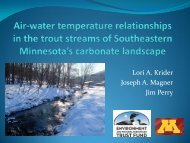Minnesota Water Resources Conference - Water Resources Center ...
Minnesota Water Resources Conference - Water Resources Center ...
Minnesota Water Resources Conference - Water Resources Center ...
You also want an ePaper? Increase the reach of your titles
YUMPU automatically turns print PDFs into web optimized ePapers that Google loves.
Concurrent Sessions V 1:15–2:45<br />
Track D: Understanding Trout Streams<br />
BOOK OF ABSTRACTS<br />
Wednesday, Tuesday, October 24 28 23<br />
Trout Stream Spring Characterization Methods and Springshed Mapping<br />
Scott Alexander, University of <strong>Minnesota</strong>, alexa017@umn.edu; Andrew Luhmann, University of <strong>Minnesota</strong>; E. Calvin<br />
Alexander, Jr., University of <strong>Minnesota</strong>; Jeffery Green, <strong>Minnesota</strong> Department of Natural <strong>Resources</strong>; and Andrew Peters,<br />
<strong>Minnesota</strong> Department of Natural <strong>Resources</strong><br />
Southeastern <strong>Minnesota</strong>’s karstlands support numerous trout streams. Dye tracing has been the primary tool<br />
for mapping springsheds supporting trout streams. A two-year study funded by the <strong>Minnesota</strong> Environment and<br />
Natural <strong>Resources</strong> Trust Fund aims to significantly increase the number of mapped springshed by integrating a<br />
variety of old and new tools.<br />
Techniques used in combination with dye tracing include temperature and discharge monitoring, detailed<br />
structural mapping, chemical and isotopic studies. New methods to define springsheds can be tested against<br />
existing, dye trace defined basins. In previously untraced basins these tools can produce more efficient dye<br />
tracing programs.<br />
Trout streams have been traditionally managed as surface water resources yet are fundamentally supported by<br />
clear, constant temperature groundwater. In karst areas groundwater resources are as vulnerable as surface<br />
waters to human activities. Designing Best Management Practices (BMPs) to protect ground water fed springs<br />
should improve the overall protection of <strong>Minnesota</strong>’s trout streams.<br />
Stream Flow and Temperature Analysis of the Vermillion River<br />
William Herb, University of <strong>Minnesota</strong>, wrherb@comcast.net; Ben Janke, University of <strong>Minnesota</strong>; Omid Mohseni, University<br />
of <strong>Minnesota</strong>; and Heinz Stefan, University of <strong>Minnesota</strong><br />
Stream temperature and stream flow are important parameters for aquatic habitat preservation in river and<br />
stream systems. <strong>Water</strong> temperature is particularly important for coldwater stream systems that support trout.<br />
Summer base flow conditions with low flows and high water temperatures can be critical for maintaining<br />
trout habitat. Surface runoff from rainfall events can lead to increases in stream temperature, particularly<br />
in developed watersheds. To better understand the interactions between stream temperature, land use, and<br />
climate, an unsteady stream flow and temperature model has been developed for the Vermillion River. This<br />
river is at the southern fringes of the Twin Cities metropolitan area and has a world-class brown trout fishery.<br />
Stream flow was modeled using two existing tools, HEC-RAS and EPA-Riv1. A stream temperature model was<br />
developed at St. Anthony Falls Laboratory, UofM, to model stream temperature response to climate variations<br />
and surface runoff on short time-scales. The 1D model includes advective transport of heat downstream, wateratmosphere<br />
heat exchange and water-sediment heat transfer. The stream temperature model uses simulated<br />
unsteady flows and observed climate data as input. The hydro-thermal response of the stream to surface runoff<br />
during storm events is simulated at 1 hour time steps and distance increments of about 200 m using summer<br />
baseflow conditions as an initial condition. In addition to detailed temperature and flow time series, the model<br />
provides broad scale characterizations of heat transport in the Vermillion, including the relative importance<br />
of groundwater temperature, atmospheric heat transfer, and surface water inputs in determining stream<br />
temperature. The stream temperature model can therefore be used as a tool to determine what management<br />
practices (e.g. stormwater BMPs, bank shading, groundwater conservation) are best to maintain cold water<br />
temperatures for trout habitat.<br />
<strong>Minnesota</strong> <strong>Water</strong> <strong>Resources</strong> <strong>Conference</strong>, October 27–28, 2008 72
















